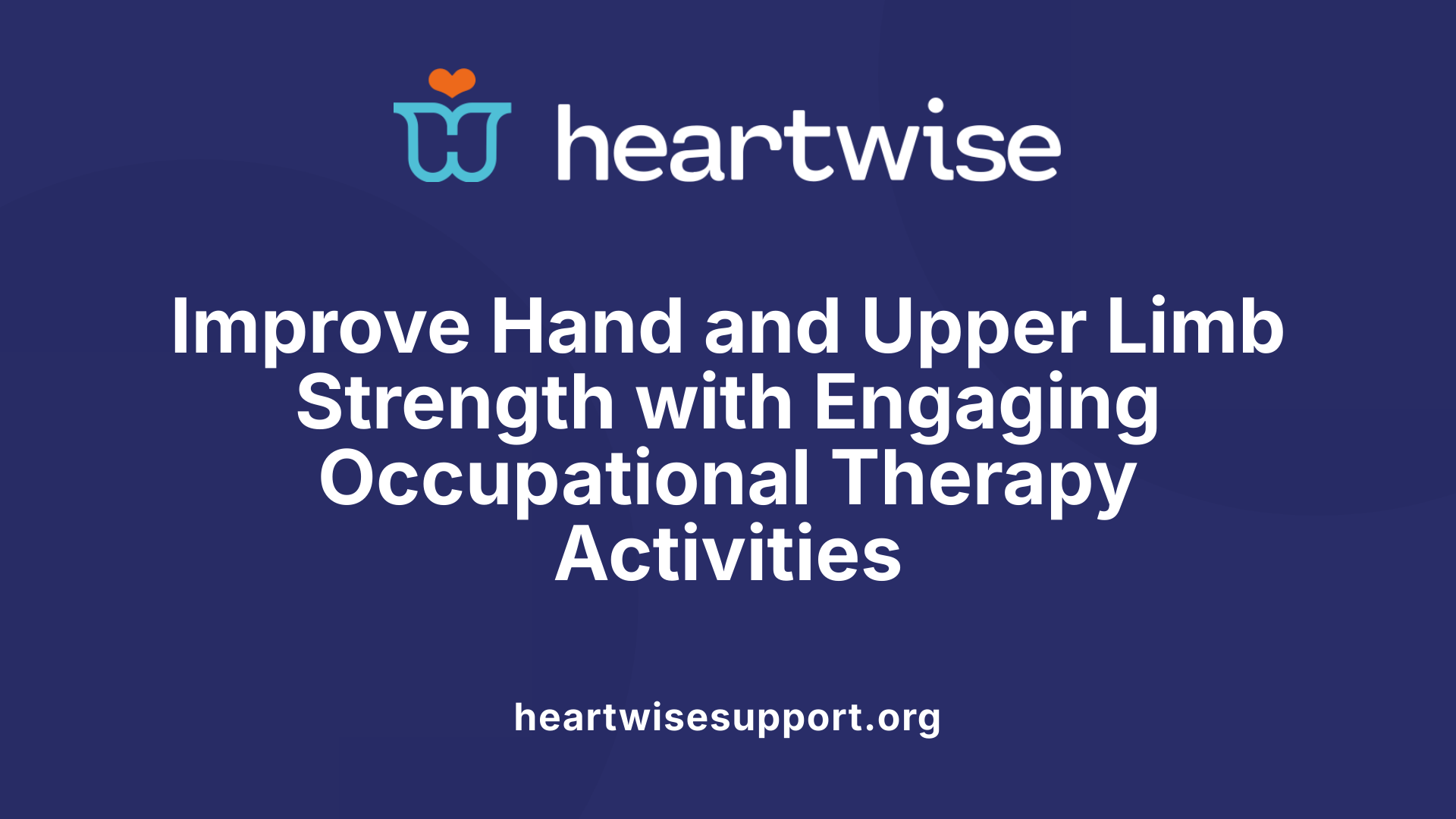Introduction to Strength-Building in Occupational Therapy
Occupational therapy (OT) plays a vital role in enhancing strength, mobility, and functional independence for individuals across all age groups. Through carefully selected activities and exercises, occupational therapists help develop muscle strength in the upper and lower extremities, improve grip, and support core stability, which are essential for daily living and overall health. This comprehensive approach not only addresses immediate functional needs but also fosters long-term physical well-being.
Effective Activities for Building Overall Strength
 Building overall strength is essential for daily function, injury prevention, and maintaining independence. A variety of exercises can help develop muscular force across different parts of the body.
Building overall strength is essential for daily function, injury prevention, and maintaining independence. A variety of exercises can help develop muscular force across different parts of the body.
Resistance training exercises are highly effective. These include lifting weights with dumbbells or barbells, using resistance bands for targeted muscle activation, and bodyweight movements such as squats, lunges, and wall press-ups. These activities challenge the muscles to exert force against resistance, promoting growth and endurance.
In addition to resistance exercises, incorporating functional movements enhances real-world strength. Movements like sit-to-stand from a chair, calf raises to strengthen the lower legs, and bicep curls to target arm muscles can improve muscle coordination and stability. Performing these regularly helps support everyday activities such as standing up from a seated position or climbing stairs.
Including balance and flexibility activities complements strength training. Stretching routines improve the range of motion and prevent stiffness, while balance exercises like unilateral stands or stability ball exercises improve posture and reduce fall risk.
A typical strength training program involves exercising at least twice a week, gradually increasing resistance or repetitions to challenge the muscles safely. Combining these with flexibility and balance exercises creates a comprehensive approach that enhances overall muscular health.
| Exercise Type | Examples | Targeted Areas | Additional Notes |
|---|---|---|---|
| Resistance training | Lifting weights, resistance bands | Whole body, focusing on major muscle groups | Use proper form; start with lighter resistance |
| Bodyweight exercises | Squats, lunges, wall press-ups | Legs, core, upper body | Suitable for all ages; can be modified for abilities |
| Functional movements | Sit-to-stand, calf raises, bicep curls | Legs, hips, arms | Mimic daily tasks to improve practical strength |
| Balance and flexibility | Stretching, yoga, stability exercises | Joints, muscles | Support muscle function and joint health |
Overall, a consistent routine combining resistance, functional, and balance exercises can significantly enhance muscle strength, improve mobility, and help prevent injuries. Tailoring activities to individual needs and gradually increasing intensity are important for safety and progression.
Activities Requiring Grip Strength

Which activities require grip strength?
Grip strength is essential for many daily tasks and recreational activities. It involves the ability of the hand muscles, especially those supporting the fingers and thumb, to exert force when grasping or holding objects.
Activities that demand strong grip include opening and closing lids of containers and bottles. These tasks require a firm hold and controlled effort to operate caps or lids securely.
Ripping tape off packages is another common activity. It involves a pulling motion that activates the muscles responsible for gripping and tearing.
Pouring water from a pitcher into cups also relies heavily on grip strength. The act of gripping the handle for stability and control is vital to avoid spills.
Stirring mixtures during cooking or baking requires sustained grip and wrist control, engaging hand and forearm muscles.
Organizing spices in a cabinet or on a shelf involves grasping small jars, tightening lids, and sometimes removing or replacing items, all of which depend on grip strength.
In occupational therapy, various exercises help enhance grip capacity. These include squeezing therapy putty, using squeeze balls or rubber bands, and performing specific functional tasks that challenge hand muscles.
Manipulative activities such as carrying trays, playing tug-of-war, or ripping fabric also demand significant grip and arm strength. These actions help develop stability, coordination, and endurance in the hand and upper limb muscles.
Fine motor skills such as manipulating small objects, cutting with scissors, tying shoelaces, and buttoning shirts are influenced by the strength and dexterity of the hand muscles.
Overall, strengthening grip is critical for independence in daily life, safety, and participation in sports and hobbies. Targeted exercises and functional activities can improve grip strength over time, making everyday tasks easier and more efficient.
Occupational Therapy Activities to Strengthen Upper Limbs and Hands
 What are common occupational therapy activities aimed at improving upper limb and hand strength?
What are common occupational therapy activities aimed at improving upper limb and hand strength?
Occupational therapists employ a variety of activities to enhance strength and coordination in the upper limbs and hands. Many of these activities integrate daily routines, making therapy practical and meaningful. For example, encouraging children to climb, dress, peel, and cut food helps develop natural muscle strength and fine motor skills.
Fine motor activities are also central to therapy. These include squeezing therapy putty or stress balls to build grip strength, pinching clothespins, and manipulating small objects with tongs or fingers. Such activities promote incredible improvements in hand muscles crucial for daily tasks.
Therapists often incorporate resistive tools like hand grippers, rubber bands, and therapy putty. These tools challenge muscles by adding resistance during squeezing and pulling exercises, which increases strength over time.
Building with Lego blocks, tearing paper, and fiddling with tiny objects further enhances finger dexterity and hand control. These tasks are designed to improve coordination and muscle endurance necessary for writing, grasping, and manipulation.
Fusing these exercises with functional activities, such as cooking, crafting, or playing musical instruments, makes therapy engaging and directly relevant to daily life. By focusing on these dynamic and enjoyable activities, occupational therapy can effectively help individuals develop upper limb and hand strength, improving independence and performance in daily routines.
Hand Strengthening Exercises in Occupational Therapy

What are some hand strengthening exercises used in occupational therapy?
Occupational therapists employ a variety of exercises to enhance hand strength and dexterity, fundamental for daily activities. Common exercises include squeezing a soft sponge or ball, which boosts grip strength and endurance. Therapists often incorporate therapy putty, which can be pinched, pushed, or squeezed to target different muscles within the hand.
Specific finger exercises help refine control and coordination. For instance, the pad-to-pad pinch involves pressing the fingertips together, the three-finger pinch engages index and middle fingers against the thumb, and the key pinch mimics holding a key, all strengthening individual fingers.
Wrist movements form a crucial part of hand therapy as well. Movements such as wrist flexion, extension, and circumduction improve overall hand mobility and support complex tasks.
These exercises are typically recommended to be performed 3 to 4 times daily, with each session consisting of about 10 to 20 repetitions. The goal is to progressively build strength without causing pain, focusing on endurance and functional use of the hand muscles.
Incorporating these targeted activities helps patients regain independence in tasks like grasping, manipulating objects, and fine motor functions essential for everyday living.
Enhancing Core Strength for Better Functional Movement
How can occupational therapy help improve core strength?
Occupational therapy plays a vital role in developing core stability, which is essential for overall movement and injury prevention. Therapists perform comprehensive assessments to evaluate muscle strength, endurance, and neuromuscular control of the core muscles. This evaluation guides the creation of personalized exercise plans focused on strengthening the muscles around the abdomen, back, and pelvis.
Core stabilization exercises such as planks, bird dogs, and pelvic floor exercises are commonly incorporated into therapy sessions. These exercises strengthen the muscles responsible for supporting the spine and maintaining proper posture during daily activities.
During sessions, occupational therapists use tactile cues to provide hands-on feedback, verbal instructions to explain proper movement patterns, and visual cues like demonstration posters or videos. These cues help clients execute exercises correctly, ensuring safety and maximizing benefits.
A stronger core improves posture, enhances balance, and increases functional movement capacity. This reduces the risk of falls and injuries, especially in older adults or those recovering from injury.
What are the effective exercises and techniques?
The core strengthening routine may include exercises such as:
- Planks (with variations for progression)
- Bird dogs for stability
- Pelvic floor contractions
- Functional activities like bridging or controlled reaching
Using different cues like tactile prompts, verbal reminders, and visual demonstrations ensures exercises are performed correctly. Proper technique is critical for effectiveness and injury prevention.
How does core strength impact posture, balance, and injury prevention?
A well-developed core aligns the spine, supports the pelvis, and stabilizes the shoulders, which collectively improve posture. Balance is enhanced because the core acts as the foundation for controlled movements.
Strong core muscles help distribute forces evenly across the body, reducing strain on joints and minimizing injury risk during physical activities. Whether in sports, daily tasks, or fall prevention, core stability is fundamental.
| Aspect | Benefit | Additional Details |
|---|---|---|
| Posture | Corrects spinal alignment | Proper core strength supports upright comfort |
| Balance | Enhances stability during movement | Crucial for activities like walking, standing, and reaching |
| Injury Prevention | Protects against falls and strains | Strong core reduces stress on other body parts |
Investing in core stability through occupational therapy not only improves functional ability but also enhances overall health and safety, fostering independence in everyday life.
Incorporating Functional and Daily Activities for Strength Development

What are some practical activities to develop strength in daily life?
Developing strength through everyday tasks helps improve functional independence and enhances overall motor skills. Practical activities include folding laundry, which builds muscle endurance and arm strength as one manages clothes of different sizes and textures.
Tossing a ball or engaging in throwing and catching exercises increases upper body strength, improves coordination, and expands range of motion. Screwing nuts onto bolts and placing pegs into holes are excellent for fine motor skills and finger strength, essential for tasks like fastening buttons or opening jars.
Engaging in play-based activities such as climbing, playing with toys, scribbling with crayons, or playing with playdough contributes to muscle development and fine motor dexterity. Building with blocks or using resistance against gripping, like squeezing therapy putty or balls, supports overall strength and endurance.
Tasks involving resistance, such as peeling, cutting, pouring, and opening containers, closely mimic daily routines and help develop hand muscles and coordination. These activities not only strengthen muscles but also improve hand-eye coordination, facilitating better performance in daily activities.
Activities that build hand and arm strength and endurance
Activities like wall push-ups, overhead reaching, gripping exercises, and towel slides enhance upper limb strength and mobility. Incorporating these into daily routines can be both enjoyable and effective.
Using tools such as squeeze balls, rubber bands, and household items like spray bottles or clothespins provides additional resistance training. Performing repetitive tasks with these items boosts hand strength and endurance over time.
Engaging in activities like climbing, playing with toys, drawing, and playdough
Children benefit greatly from activities that promote both gross and fine motor skills. Climbing on playground equipment or in sports encourages overall body strength. Drawing and using playdough help strengthen small muscles in fingers and hands, essential for writing and other precision tasks.
Encouraging children to participate in these activities during everyday play supports muscle development while also fostering independence and confidence.
Activities like peeling, cutting, pouring, and opening containers that support hand muscles and coordination
Simple household tasks like peeling vegetables, cutting with safety scissors, pouring liquids, and opening jars are excellent functional activities. These tasks improve hand-muscle strength, coordination, and dexterity.
They replicate real-life activities, making occupational therapy practical and relevant. Repeated practice of these skills enhances precision, grip strength, and coordination, contributing to improved performance in daily self-care routines.
| Activity Type | Specific Exercises | Targets | Additional Notes |
|---|---|---|---|
| Gross Motor | climbing, playing, jumping | overall strength, coordination | Supports muscle groups and balance |
| Fine Motor | drawing, playdough, threading | finger, hand, wrist strength | Enhances precision and dexterity |
| Functional Tasks | folding laundry, pouring, opening | hand muscles, endurance | Mimics daily routines and improves independence |
| Resistance Exercises | squeezing balls, use of therapy putty | grip strength, endurance | Builds muscle over time |
Incorporating these activities into daily routines and therapy sessions can promote muscle development, functional independence, and a greater ability to complete everyday tasks effectively.
Empowering Independence through Strength Building
Occupational therapy leverages targeted activities and exercises to build strength in key muscle groups, enhancing daily functioning and independence. From fine motor activities for children to core stabilization exercises for adults, incorporating functional and engaging routines ensures sustained progress. Regular participation in these tailored activities not only improves muscle force and endurance but also promotes balance, coordination, and overall health, empowering individuals to participate confidently in everyday life and achieve their personal goals.
References
- 7 Upper Body Strength OT Activities That Can Help
- Hand Strengthening Exercises for Kids - The OT Toolbox
- Occupational Therapy Activities for the Upper Body
- [PDF] HAND & FINGER STRENGTH INFO E - The Royal Children's Hospital
- Strengthening Exercises | Gross Motor | Therapy Resources
- Strength Assessment and Interventions – Occupational Therapy ...
- 39 Hand Therapy Exercises to Improve Strength and Function
- Functional Activities for Grip Strength - The Note Ninjas
- 5 Simple Occupational Therapy Exercises to Improve Mobility and ...











